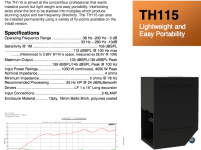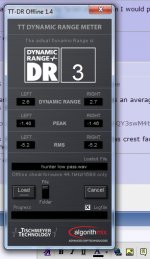First post says "weight TBD", probably with Baltic Birch around 150 pounds (68 kg).Furthermore can anyone comment on the weight of one of these? I will have to manage them single handed unfortunately.
Lighter wood could save around 15-20 pounds (7-9 kg).
At my old sound company the guys would have considered them "patio furniture" regarding weight
Hi sine 143,
Could you, please, post your simulation for the PAL12 with the 12tbx100 driver?
Regards,
Sine, do you still have the sim?
Here ya go.
the TBX100 is a bit peakier in response and slightly less sensitive, but you'll notice the low end peak is noticeably lower. It will also take 60 volts before exceeding xmax, where as the lab 12 will only take about 40 or so (loose suspension lets the woofer exceed xmax in passband, and a slightly lower RE)
EDIT, needed to fix the pic
the TBX100 is a bit peakier in response and slightly less sensitive, but you'll notice the low end peak is noticeably lower. It will also take 60 volts before exceeding xmax, where as the lab 12 will only take about 40 or so (loose suspension lets the woofer exceed xmax in passband, and a slightly lower RE)
EDIT, needed to fix the pic
Attachments
Last edited:
It honestly all depends on what the real world response looks like.
MRGSR noticed that the "saddle" resp on his lab12 loaded ones was smoother IRL. You pick up about 2 db of output and 5 dbs of output at 35 hz (as well as significant output increases between 35 and 45). Power compression should be lower, and if the tbx loaded box exhibits the same lack of saddle dip you could be picking up as much as 3 db per box (and 5 to 10 hz extension).
the 12bg100 also helps relieve some of the saddle response (modelled at least, with similar power handling (maybe slightly more), and very few differences other than that.
MRGSR noticed that the "saddle" resp on his lab12 loaded ones was smoother IRL. You pick up about 2 db of output and 5 dbs of output at 35 hz (as well as significant output increases between 35 and 45). Power compression should be lower, and if the tbx loaded box exhibits the same lack of saddle dip you could be picking up as much as 3 db per box (and 5 to 10 hz extension).
the 12bg100 also helps relieve some of the saddle response (modelled at least, with similar power handling (maybe slightly more), and very few differences other than that.
The DSL TH115 uses the B&C TBX100, it is rated for 1000 watts continuous.the b&c do have plenty of xmech, however most danley products use the 4 ohm models of these woofers AND i'm under the impression that danley uses the 15sw115 from bc which has considerably more xmax than the tbx100.
the THmini uses the 12tbx100.
The DSL TH118 uses the B&C18SW115, but the 15SW115 was not adopted as the minor increase in output was not worth the added expense and sensitivity loss.
Attachments
If your "music" has a 10 dB crest factor, 2000 watt peaks only result in an average of 200 watts or so, no problem for a speaker rated 1000 watts AES, the AES test signal has only 6 dB dynamic range.In other words 2000W for music content?
On the other hand, if your "music" is sine waves, 1000 watts is 3 dB too much.
Who was it that said the TH-115 "taps out x-max at 500W"?
Did they back up the statement with any measurements and say at what frequency they found the speaker exceeding Xmax, and what did they consider Xmax to be?
Weltersys, I read it on a forum here "Obviously, but with most non-synthesised instruments (like electric bass) the harmonics have at least as much power as the fundamental, so even if you play a low C on a 5 string bass at 32Hz the power at 32Hz isn't as high as some synthesized bass notes at the same frequency, because there's considerable power at 64Hz, 94Hz and so on.
So in this case you will never hit the Xmax predicted by Hornresp for a full-power sinewave -- for example the 15TBX100 in the Danley TH-115 will run out of Xmax at around 600W on sinewaves, but the driver is rated at 1000W and a 2000W amp is recommended for music applications." http://www.diyaudio.com/forums/subwoofers/170749-15-tapped-horn-rcf-9.html
I got it slightly wrong, should be 600w.
I would say at most, a lot of the edm I would play is somewhere between -5 to -10db rms.
So in this case you will never hit the Xmax predicted by Hornresp for a full-power sinewave -- for example the 15TBX100 in the Danley TH-115 will run out of Xmax at around 600W on sinewaves, but the driver is rated at 1000W and a 2000W amp is recommended for music applications." http://www.diyaudio.com/forums/subwoofers/170749-15-tapped-horn-rcf-9.html
I got it slightly wrong, should be 600w.
I would say at most, a lot of the edm I would play is somewhere between -5 to -10db rms.
The low note on a 5 string bass is a "B", not a "C", but the rest of what Iand says is correct.I got it slightly wrong, should be 600w.
I would say at most, a lot of the edm I would play is somewhere between -5 to -10db rms.
However, excursion is no greater with a sine wave than any other type of signal with the same peak, but sine waves have more average power, and therefore will burn the voice coil faster than most music forms, none of which I have seen to have only a 3 dB crest factor.
The DSL TH-115 has its excursion minima around 35 Hz, assuming one employs the recommended 25 Hz BW24 HP, the voice coil would much more likely burn than the driver experience mechanical problems with LF sine waves. The driver will more likely exceed Xmax around 50 Hz, but the 15TBX100 suspension keeps excursion under control as the magnet force diminishes past Xmax.
The AES signal used for the B&C 15TBX100 power rating has 6 dB dynamic range, I would be interested to see examples of any popular EDM music that has an average crest factor less than that.
What do you mean by "a lot of the edm I would play is somewhere between -5 to -10db rms" ?
Art
Last edited:
LAS - Preaching - Box Clever - YouTube
when lopassed at 100hz, this track has an average crest factor of 3 (after the bassline drops of course). Its in no way an example of "popular edm" but it is the style that I play.
Kaiju ft. Flowdan - Hunter [OSMUK029] - YouTube
this track (when lopassed at 100hz) has crest factor ranging between 4 and 2.5 THROUGHOUT (after bassline starts), centered at 34/35 hz (shall we call it the TH115 killer?)
attached is an image of the "dynamic range level" (actually just a crest level measurment) of the first 32 bars after the bassline starts in hunter, lowpassed at 100 (24db/oct). I would do the whole song but its basically just minute variations.
these are basically the first 2 of about... 2000 similar tracks in my library. Hunter is known for its particularly brutal bassline, but its not particularly special. Id expect almost every track in my library to measure under a 5 on the DR meter when lowpassed, and the bass is basically continuous for 54 seconds, followed by a few seconds break, then continuous again for 54 seconds, rinse repeat.
when lopassed at 100hz, this track has an average crest factor of 3 (after the bassline drops of course). Its in no way an example of "popular edm" but it is the style that I play.
Kaiju ft. Flowdan - Hunter [OSMUK029] - YouTube
this track (when lopassed at 100hz) has crest factor ranging between 4 and 2.5 THROUGHOUT (after bassline starts), centered at 34/35 hz (shall we call it the TH115 killer?)
attached is an image of the "dynamic range level" (actually just a crest level measurment) of the first 32 bars after the bassline starts in hunter, lowpassed at 100 (24db/oct). I would do the whole song but its basically just minute variations.
these are basically the first 2 of about... 2000 similar tracks in my library. Hunter is known for its particularly brutal bassline, but its not particularly special. Id expect almost every track in my library to measure under a 5 on the DR meter when lowpassed, and the bass is basically continuous for 54 seconds, followed by a few seconds break, then continuous again for 54 seconds, rinse repeat.
Attachments
Last edited:
That is some seriously squashed shiuf!when lopassed at 100hz, this track has an average crest factor of 3 (after the bassline drops of course). Its in no way an example of "popular edm" but it is the style that I play.
this track (when lopassed at 100hz) has crest factor ranging between 4 and 2.5 THROUGHOUT (after bassline starts), centered at 34/35 hz (shall we call it the TH115 killer?)
these are basically the first 2 of about... 2000 similar tracks in my library. Hunter is known for its particularly brutal bassline, but its not particularly special. Id expect almost every track in my library to measure under a 5 on the DR meter when lowpassed, and the bass is basically continuous for 54 seconds, followed by a few seconds break, then continuous again for 54 seconds, rinse repeat.
As the TT Dynamic Range Meter manual says "unfit for consumption"
Easy to see why that genre can roast cones, thermal amps, and blow breakers so quick.
If you are primarily playing that type of music, your subs would be safe if you limit them to only half of the AES continuous rating, that would be 200 watts for the Lab12 and 500 watts for the 15TBX100.
With only 3 dB crest factor most speakers will be in to 3 dB power compression within one song anyway, so the AES rating could be used
Funny, if the producers of that 3 dB crest factor stuff put in some upper bass harmonics, the bass would sound louder and require half the subs.
Of course, with most DJs running their speakers past Xmax, the harmonics get added in automatically
Art
Last edited:
- Home
- Loudspeakers
- Subwoofers
- $325 Lab 12 based PA tapped horn ~ 35Hz extension


